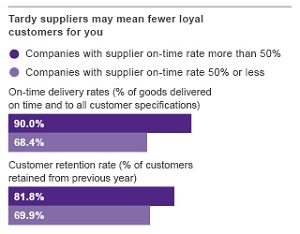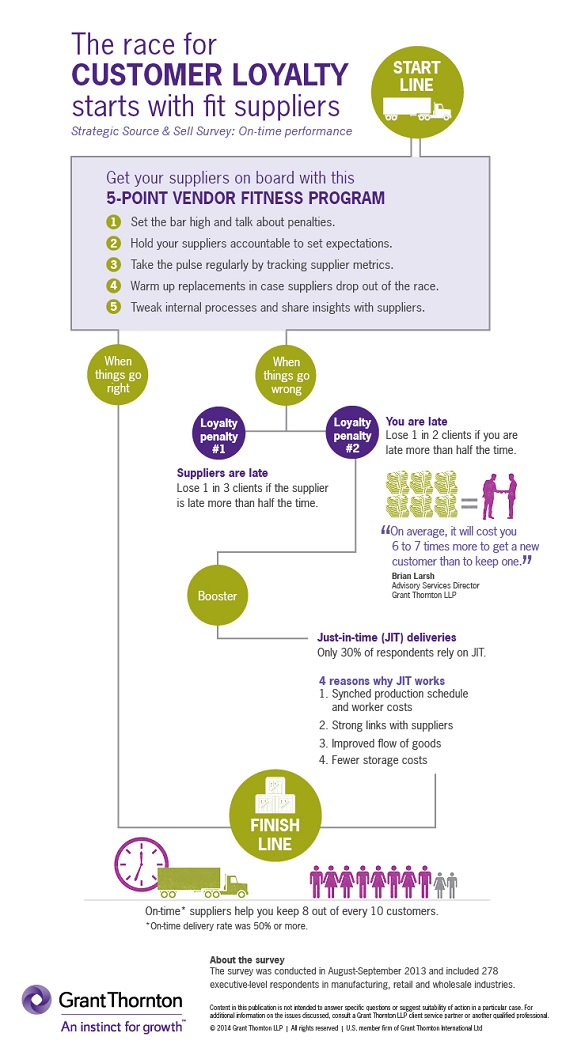Research examines link between supplier performance and customer loyalty, which to address first
Study uncovers facts supporting rule of thumb; it costs seven times more to land a customer than to retain one.

Many manufacturers, retailers and wholesalers can expect to replace half of their customer bases each year, according to Grant Thornton’s Strategic Source and Sell Survey.
The study quantifies the commonsense impact of upstream suppliers on downstream performance, but Brian Larsh, advisory services director at Grant Thornton LLP, said in a recent interview that the study also challenges some assumptions about how to improve.
“I was taught that you get your own house in order, then you look up at your suppliers, then you look down to your customers,” Larsh said. “The future might show that looking down comes first.”

Source: Grant Thornton
For some perspective, the businesses reporting on-time customer delivery rates of 50% or worse (about one in five companies), the customer retention rate is only 52%. Compare that with the average 76% retention rate for respondents with 79% on-time deliveries.
Respondents then reported that on-time supplier-goods delivery rates of 50% or worse limit their on-time delivery to customers to just 68%, where retention rates end up at 70%. Prompt suppliers were associated with on-time delivery to customers at 90%, with customer retention at 82%.
“We were pleased to see the numbers support what had been a hypothesis for some time,” Larsh said. “The sample size and cross-section was good and the more I got into the data the better I felt about it.”
The report illuminated both poles of performance, providing what Larsh called a surprising amount of poor performance. “One fifth achieves on-time delivery less than half of the time,” he said. “If I were in charge of those companies we would be putting in some long days to make that performance better.”
Larsh also noted that manufacturers often reported the best performance, but retail operations were among the worst performers “I think they need to be the best,” he said, “because they are right next to the ultimate customer.”
Interestingly, the research shows a parallel between the customer’s ability to switch retailers with the click of a mouse and the retailer’s ability to do the same with suppliers.
“This prevents these operations from ever getting into a performance improvement groove,” Larsh said. “We also see an unwillingness to share data, for some reason. People believe it’s private or proprietary. That wall has to be broken down so there’s a sharing of information, which is more available than ever.”
Larsh advised businesses to be realistic and observant while communicating readily with suppliers. Perhaps a performance dashboard of some kind could relay data about on-time deliveries upon receipt, and there should be consequences.
Larsh also advised against neglecting the role of the consumer in this exchange. “We’re moving toward the anticipatory supply chain, where companies are losing their advantages to forward thinkers who are looking at predictive models,” he said. “Real-time capabilities suddenly start to seem a bit short-sighted.”
A few ways to keep suppliers accountable:
• Establish a high bar for suppliers. Set criteria that assumes perfection or — at worst — conforms to benchmark industry performances. Clearly outline penalties, keep a scorecard, and enforce consequences, including cancellation of the order.
• Monitor performances rigorously. Track supplier metrics by shipment, hour, day, week, etc., and demand remediation for anything less than contracted performance. Also, talk to your suppliers regularly about their performance. Start with your larger suppliers and go over their performance dashboard on a weekly or monthly basis. Extend these regular touch points to all your suppliers and leverage the metrics when you renegotiate or renew contracts.
• Develop competitive alternatives. Establish redundancy in the supply chain, which is an opportunity to weed out weak performers with minimal impact to operations and to customer deliveries and satisfaction.
• Keep improving. Constantly evaluate and advance internal processes like procurement, logistics, production, shipping, collaboration and handoffs with suppliers. Encourage or even require that suppliers have organic improvement processes and discuss actively how sharing the benefits leads to more business.
• Review your supplier contracts. Many businesses make the mistake of not including expected performance metrics in their supplier contracts. This leaves the door wide open for missed deliveries and will deeply affect your profitability. If updating your current contracts is not possible, make sure to at least include metrics in the new ones.
Demographics:
278 executive respondents in August and September of 2013
• CEO: 20%
• President: 17%
• CFO: 16%
• Partner: 14%
• Manufacturers: 61%
• Retailers: 24%
• Wholesalers/distributors: 23%
• Private: 90%
• Public: 10%
• Less than $50 million: 66%
• $50 to $100 million: 12%
• $101 million to $500 million: 13%
• More than $500 million: 8%
JIT: study highlights this profitable strategy
According to Grant Thornton’s research, just-in-time (JIT) deliveries are particularly valuable to manufacturers. They reduce in-process inventory and related carrying costs. However, the survey found that, on average, only 30% of purchased dollar volume is received on a JIT basis.
“If your suppliers are unreliable, you have to stock more materials to make sure you keep your deliveries on track,” said Larsh. “When you have more stock, your production, storage and utility costs go up, and there’s more chance for errors in your operations.”
Here are a few reasons why JIT deliveries can be a profitable strategy:
• Production schedule and worker costs can be synchronized with demand.
• You can establish strong, long-lasting relationships with your supply chain.
• Improved flow of goods leads to better inventory planning and lower storage costs.
• You can use your multiskilled workers more efficiently.
• Your inventory is less likely to expire or be damaged.


Article Topics
Latest in Logistics
Shipment and expenditure decreases trend down, notes Cass Freight Index March trucking tonnage trends down, reports ATA FTR Shippers Conditions Index enters negative territory DAT March Truckload Volume Index sees modest March gains National diesel average, for week of April 22, is down for the second straight week UPS reports first quarter earnings decline LM Podcast Series: Assessing the freight transportation and logistics markets with Tom Nightingale, AFS Logistics More LogisticsAbout the Author
Subscribe to Logistics Management Magazine

Find out what the world's most innovative companies are doing to improve productivity in their plants and distribution centers.
Start your FREE subscription today.
April 2023 Logistics Management

Latest Resources














